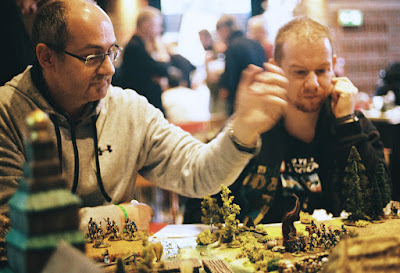Here are my impressions about the Tactica 2016. Also check out the first part of my text about this excellent wargaming convention in Hamburg.
The second game the Kurpfalz Feldherren presented this year was a skirmish game using the ruleset "Donny Brock". After the Swedish soldiers had lost the battle of Lesnaya in 1708, they were supposed to destroy supplies which the Russian troops wanted to catch. Jörg and I decided to play the Russians, basically because playing the Russians we were allowed to control a toy boat, quite a beautiful model. Krüger and another man played the Swedish. The other man wasn’t the same other man Krüger had played the battle of Lesnaya with. He was yet another man and was the commander in chief on their side.
This game, too, worked with a card deck which organised whose turn it was and on which side reinforcements would arrive. The scenario worked this way: at the beginning both players had the same number of troops, but the quality of the Swedish troops was much better. During the game more and more Russian troops would arrive. So as the Swedish player, you had to act quickly, destroy objectives and get your troops over a river that divided the board. (I quite like the scenario and would like to use it in one of our games.)
Krüger and the other man managed to destroy several objectives in the first rounds, but then the Swedish commander in chief decided to wait, instead of crossing the river with a wagon. This made Krüger nervous. While Krüger spends a lot of time patiently waiting in real life, he prefers to act quickly as a wargamer. More and more Russian reinforcements arrived. Jörg and I were able to make up for a bad start. We secured several objectives and finally won the game.
Jörg enjoyed this so much, that he bought the ruleset "Donny Brock". He also tried to buy some 28 mm Swedish tin soldiers from Wargames Foundry, but they were sold out.
Saturday night, we met one of Jörg’s friends who wanted to show us St. Pauli. We ended up in the bar of our hotel Superbude. While the others were talking about smart phones and trying cocktails with funky names, I sat in a comfortable chair, drowsing and thinking about our first day at the Tactica.
People who present participation games at wargaming conventions spend a lot of time doing so, I thought. They invent rules, paint models, make a board, model trees and little houses. Then they transport everything to the convention, prepare the game, explain the rules to the players, over and over again. Large games take about two hours to play and involve four to six players. As a game master you can run about three games a day, I suppose. So they do all this for a handful of people who play their games. And there is no money involved. That’s great, I think. Ok. A lot of people walk by, look at the tables, take pictures. And many more people look at the pictures when they are later published on the internet. Thinking about it, some people might go to conventions because of the amazing participation games and then buy stuff from the vendors, so there is some money involved, I guess. Anyways. I believe people who present participation games at wargaming conventions get a lot of respect from the wargaming community. Well, they should. Hell, they get my respect!



They certainly get my respect too, the amount of work that must go into planning and preparing a participation game must be immense.
ReplyDeleteIn the UK I used to belong to a club that put on participation games at shows. There *is* a lot of work goes into designing and presenting them, but to be fair it *is* a lot of fun. Ours were tested mercilessly at the club in the months before their first outing, so we all got to enjoy the results of our labours before anyone else did. And the UK has enough shows that we could take the game to several during the year, which made the time spent devising the game worthwhile.
ReplyDeleteOur games were generally designed for about six players, with two or three people running the actual game and a play time, including explanations, of about an hour. We wrote our own rules to give us exactly the game we wanted.
I miss it; Australia doesn't lend itself to the same kind of game, and our group lacks the necessary people to drive that particular kind of project.
The games you showed at conventions in the UK sound like fun.
DeleteI went to a couple of conventions in Germany over the last years. I think, participation games often take much longer than planned and are always lots of fun. This year, at a convention in Hamburg one of the organizers of such a game told me that it takes him about a year to prepare one. He said, he puts everything in boxes after the show and never plays the game again. That’s an amazing effort to put into a participation game, I think. And very altruistic.